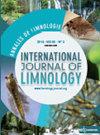Zooplankton egg bank: characterization and effect of biotic factors on hatching
IF 0.9
4区 环境科学与生态学
Q4 LIMNOLOGY
Annales De Limnologie-international Journal of Limnology
Pub Date : 2023-01-01
DOI:10.1051/limn/2023002
引用次数: 0
Abstract
Many zooplankton organisms facing harsh environmental conditions producing resting eggs. Resting eggs accumulate in the sediment and create a resting egg bank. Knowledge on the egg bank structure, morphology and morphometry of the eggs as well as the effect of cues on hatching, contributes to the understanding zooplankton dynamics in lakes. Here we described the composition and structure of zooplankton egg bank from a shallow tropical lake and analyzed the effect of some biotic factors on hatching rates. In order to describe the structure and composition of the resting egg bank, we determined the richness, density, morphology and morphometry of the resting eggs isolated by the sugar flotation method. Diapausing eggs were measured and their external features studied by microphotography under optical microscope and SEM. To analyze the effect of biotic factors on hatching rates, we exposed the resting structures and the entire sediment to three biotic factors: a chlorophyte (Scenedesmus acutus), a cyanobacteria (Microcystis sp.) and a predatory rotifer (Asplanchna girodi). A total of 25 zooplankton species hatched from the sediments. Our results show that the medium density of the healthy-looking diapausing eggs was of 7.6 ± 2 diapausing eggs · cm−3 and that rotifers are the predominant group in the egg bank. Medium conditioned with the chlorophyte and the cyanobacteria resulted in a higher hatching rate. The ornamentations of rotifer diapausing eggs present different features, such as wrinkles and spines, which can help to taxonomic identification without the need of promoting hatching.浮游动物卵库:特征及生物因子对孵化的影响
许多浮游动物面临恶劣的环境条件产生休眠卵。静止的卵聚集在沉积物中,形成一个静止的卵库。了解卵库的结构、卵的形态和形态测量以及线索对孵化的影响,有助于了解湖泊浮游动物的动态。本文描述了热带浅水湖泊浮游动物卵库的组成和结构,并分析了一些生物因素对孵化率的影响。为了描述静息卵库的结构和组成,我们测定了糖浮选法分离的静息卵的丰富度、密度、形态和形态计量学。在光学显微镜和扫描电子显微镜下对滞育卵进行了测量,并对滞育卵的外形特征进行了研究。为了分析生物因子对孵化率的影响,我们将静息结构和整个沉积物暴露于3种生物因子:绿藻(Scenedesmus acutus)、蓝藻(Microcystis sp.)和掠食性轮虫(Asplanchna girodi)。总共有25种浮游动物从沉积物中孵化出来。结果表明,健康滞育卵的中密度为7.6±2个·cm−3,轮虫是卵库中的优势类群。以绿藻和蓝藻为条件的培养基孵化率较高。轮虫滞育卵的纹饰表现出不同的特征,如皱纹和刺,这有助于在不促进孵化的情况下进行分类鉴定。
本文章由计算机程序翻译,如有差异,请以英文原文为准。
求助全文
约1分钟内获得全文
求助全文
来源期刊
CiteScore
2.20
自引率
0.00%
发文量
0
审稿时长
>12 weeks
期刊介绍:
Annales de Limnologie - International Journal of Limnology publishes papers on the ecology of freshwater systems, ranging from studies of aquatic organisms, physical and chemical works which relate to the biological environment, to ecological applications and frameworks for water management directives.
Main topics: Ecology of freshwater systems ; biodiversity, taxonomy, distribution patterns in space and time, biology of animals and plants ; experimental and conceptual studies which integrate laboratory and/or field work on physiology, population dynamics, biogeochemistry and nutrient dynamics, management, mathematical modelling ; techniques for sampling and chemical analyses, ecological applications, procedures which provide frameworks for environmental legislation.

 求助内容:
求助内容: 应助结果提醒方式:
应助结果提醒方式:


